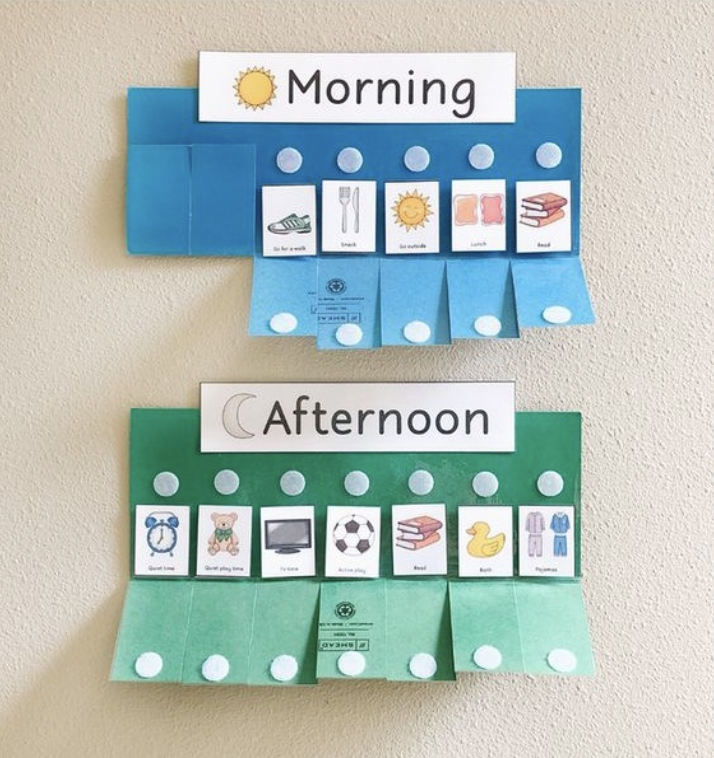Reduce stress with a solid back-to-school routine
August 17, 2022
by Lindsey Flannery

Whether you’re a parent who loves the predictable routine that the school year brings, or you’re dreading the end of long, unstructured summer days, having a solid back-to-school schedule can help ease the transition.
Creating a predictable structure around your day helps you reduce stress, feel more organized, and have more time for activities you enjoy. (You can call it a family “rhythm” if you cringe at the idea of a “schedule.”)
A back-to-school schedule isn’t just for parents’ sanity: we know that children benefit from structure and predictability, too. It makes them feel safe, it reduces whining and boredom, and it helps them develop the skills and habits they need to structure their own lives as they become more independent.
So, how do I create a back-to-school schedule?
A good schedule is well-planned and predictable. It gives you just enough structure to make the day’s transitions easier, while making it clear where there is wiggle room for the spontaneity you or your children may crave.
First, get clear on everything that has to happen in your day, especially the items with time deadlines (school dropoff and pickup, after school activities, etc.)
Then, fill in the rest of your tasks based on those times. For example, if your child needs to be on the bus at 7:45 a.m., and you know that her morning tasks will take her 45 minutes and you want half an hour of buffer time, plan her wake-up time for 6:30 a.m.
Include the child’s tasks on your schedule. For some children, creating a visual version of their tasks can really help them take ownership to complete them independently, without prodding from you. (This is the stuff morning dreams are made of, yes?)
Example morning tasks for your child:
- Wake up
- Brush teeth and hair
- Get dressed
- Eat breakfast
- Fill water bottle and place in backpack
- Put on shoes and jacket
Example after-school tasks for your child:
- Wash hands
- Eat snack
- Outdoor play time
- Homework
- Dinner
- Pack bag and lay out clothes for tomorrow
- Brush teeth
- Put on pajamas
- Stories with Mom or Dad
- Bedtime
You can add times and/or time limits to each task or activity as you see fit. The best routine for your family and child is one that you will stick to, that actually makes your day feel more easeful. See below for a simple craft that will help visual learners move through their daily tasks.
Get organized ahead of time
If you start the routine of going to bed early the night before school starts, when the pre-first-day jitters are in full effect, you’re setting your kids up for a rough night of sleep, which carries over into their day. Instead, start nudging bedtime and wake up time earlier, in smaller increments, in the days before school starts. A well-rested child is happier and better able to regulate their emotions (same goes for adults).
Get yourself organized, too. Getting back into the school rhythm leaves less time for your daily tasks, so planning ahead helps make the most of your time. Implement the following to save time:
- Plan your meals, so you don’t waste time figuring out what to have for dinner. Do one larger grocery trip rather than several small ones, and consider making extra food for the week ahead on Sunday.
- Consolidate errands. Keep a list of everything that needs to be done, and set a designated time to accomplish them all and save trips.
- Create a shared calendar. You can use Google Calendar (if all users have gmail addresses) or any number of available apps, so everyone in the family can add activities and see what’s coming up. Or if you’re more of an analog family, hang a shared calendar on the fridge and write in activities.
Be flexible
Allow enough time to avoid feeling rushed. Some kids need more time than others; some need verbal or visual reminders to stay on task. Adjust your schedule if what you’ve planned isn’t working. The energy in your house in the morning sets the tone for the whole day. If you can keep it cool and lighthearted, everything that follows will go smoother, too.
What matters most about your back-to-school schedule is that it works for you. It doesn’t have to be a color-coded, pinterest-worthy, super-mom endeavor. Simply having a general outline of the day posted on the fridge that you can turn to when things feel chaotic will help you feel more relaxed.
DIY kids’ routine craft
For many kids, it’s hard to stay “on-task” in the morning. Playing with toys or horsing around with siblings are more appealing than putting on clothes and brushing teeth. This is where a visual schedule comes in to help with transitions:
- Make the tasks visual
- Put them in order
- Give the child a way to mark them complete
- Provide an incentive, if needed.
If your child needs extra motivation, you might, for example, give them extra screen time or a trip to the trampoline park when they collect 20 stickers (one for each time they complete all their tasks themselves). Be creative when figuring out what motivates your child.

What you need:
- Two file folders
- Sticky velcro tabs
- Scissors
- Ruler
- Markers or crayons
- Glue stick
- Cut the top half off the file folder. Then, determine how many tasks to include in your child’s morning or afternoon routine. Divide the width of the top flap of the file folder equally into that many sections, marking with a pencil. At each pencil mark, cut into the top flap until you reach the folder crease. (See photo.)
- Draw pictures of each task directly into the folder, or on small pieces of white paper that fit behind each flap, and glue. Depending on your child’s age, they can help with this. Alternatively, you can print and glue clip art (as pictured in the photo above). Affix velcro dots above each task picture, and on the inside of the flap so the dots match up.
- Draw, print, or glue a heading on your creation, like “Aria’s Morning Routine.”
- Have your child velcro each flap closed when the task is completed, and enjoy the ease it brings to your day!
